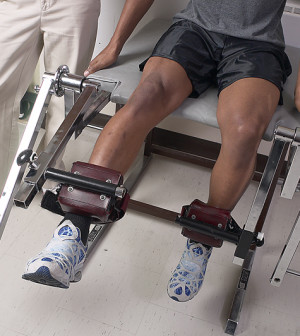- Skip Storing This Everyday Product in the Fridge Door
- Green Tea + B3 Pairing May Boost Brain Health
- Navigating Your Midlife Crisis: Embracing New Possibilities
- City Raccoons Showing Signs of Domestication
- Mapping the Exposome: Science Broadens Focus to Environmental Disease Triggers
- One Week Less on Social Media Linked to Better Mental Health
- Your Brain Changes in Stages as You Age, Study Finds
- Some Suicide Victims Show No Typical Warning Signs, Study Finds
- ByHeart Formula Faces Lawsuits After Babies Sickened With Botulism
- Switch to Vegan Diet Could Cut Your Greenhouse Gas Emissions in Half
Turkey Day Touch Football Might Lead to Ankle Injuries

Touch football is an important Thanksgiving tradition for many Americans, but more than 25,000 people will suffer a serious ankle injury during those games, the American College of Foot and Ankle Surgeons (ACFAS) says.
If you’re among those who gets a Turkey Day ankle injury, proper treatment is essential. Otherwise, you could develop long-term ankle problems, the experts cautioned.
“The severity of an ankle sprain depends on whether the ligament is stretched, partially torn, or completely torn, as well as the number of ligaments involved,” Dr. Gregory Catalano, a Massachusetts foot and ankle surgeon, said in an ACFAS news release.
“While the RICE method (rest, ice, compression, elevation) combined with nonsteroidal anti-inflammatory drugs, such as ibuprofen, will minimize swelling and pain, we find most patients do not give themselves enough time to rehabilitate and heal,” he said.
People who suffer an ankle sprain should limit walking and exercise for two weeks, according to the ACFAS.
They said it’s also important to monitor for signs of more serious problems that require medical attention. These include:
- redness, swelling or pain in other parts of the leg (which can be a sign of a blood clot);
- no improvement in the ankle over five days to a week;
- being unable to put weight on the ankle or continued inability to walk on the ankle more than a few steps without pain;
- swelling or bruising that lasts more than 14 days;
- a deformity, or severe midfoot swelling below the ankle.
An untreated ankle sprain can lead to chronic ankle instability, which results in constant discomfort and the ankle giving way, the ACFAS said.
More information
The American Academy of Family Physicians has more about ankle problems.
Source: HealthDay
Copyright © 2025 HealthDay. All rights reserved.










